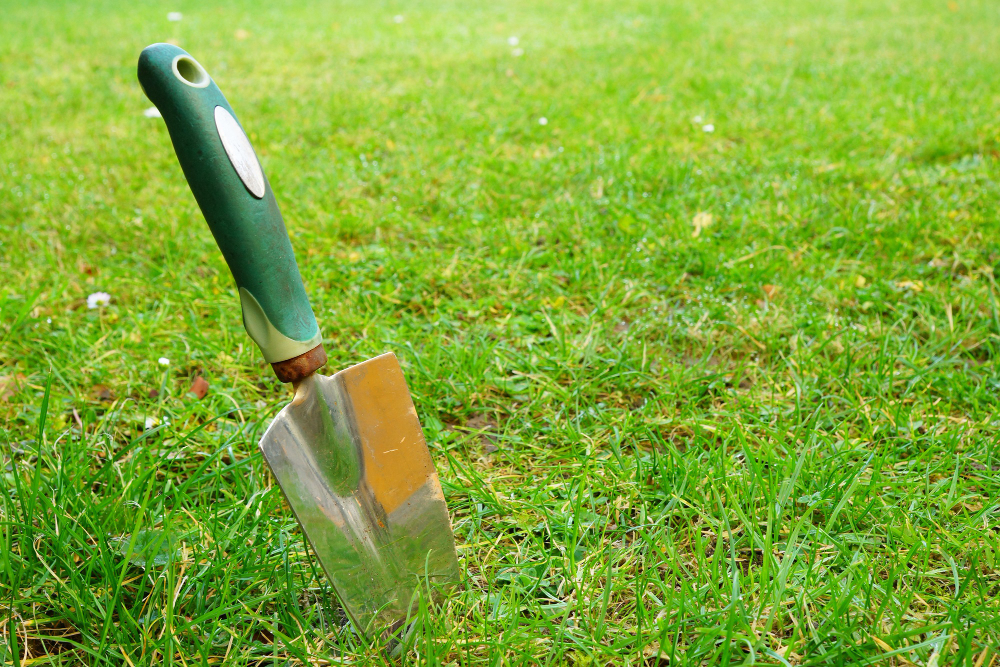- Lawn Turf
- Artificial
- Soil
- Timber
- Composite Decking
- Paving & Stone
Get In Touch With Our Experts Today!
Give us a Call! - Seed & Fertiliser
- Dressing
- Bark

October 03, 2025 Autumn TurfTurfTurf AdviceTurf Tips
October is a pivotal month in the lawn care calendar for homeowners and landscapers. Whether you’re installing fresh turf or overseeding to repair an existing lawn, it’s the ideal window to set your turf up for success through winter and into spring. At George Davies Turf & Stone, we’re here to support you with autumn lawn care tasks. Our October turf tips will help you enhance, protect, lay, or repair your turf this month. So, let’s roll up our sleeves and get into it!
Yes! Unless the ground is frozen, you can absolutely install natural grass or artificial turf in October. Laying turf in autumn can give your lawn the best chance to succeed; the cooler weather conditions mean your turf doesn’t dry out as quickly, there’s still enough sunlight to feed the roots, and light rainfall means it stays hydrated!
If you’re installing turf in October, check out our guide to laying turf, which includes a step-by-step guide and a video from George himself, or read our best advice for buying and laying turf in winter. You can also view our range of high-quality turf products:
Follow these five easy steps to keep your grass lawn in tip-top shape:
Should I scarify in October? This is a popular question. The answer? Yes! Aerating and scarifying your turf will help create channels in compacted soil, allowing water, oxygen, and nutrients to reach the grass roots. This will keep them fuelled throughout winter when resources are scarce.
Aeration and scarification also help with increasing levels of rainfall. Compacted soil struggles to absorb water; if we experience heavy downfalls, water will stay on the surface, potentially leading to flooding. By aerating or scarifying your lawn in October, you help improve your soil’s water retention and prevent your lawn from waterlogging.
Is October too late to put autumn feed on the lawn? Not at all! This is possibly your last chance to apply autumn grass feed, but also, the best time! Autumn brings cool air temperatures and damp conditions – ideal for applying grass autumn fertiliser.
Autumn feed is formulated with potassium and phosphorus, which help strengthen grass blades and root growth. These properties are essential in Autumn as they build resilience throughout the colder weather and encourage a healthier lawn and better growth come spring.
Top tip: Avoid using leftover summer fertiliser – this contains the wrong type of nutrients for the season.
You may begin to notice more moss appearing across your lawn. Although moss isn’t harmful to your lawn, if left, it can cause damage. Moss appears on your lawn when the grass is stressed or struggling to grow. This may be due to poor drainage, too much shade, or compacted soil, which prevents the roots from accessing essential nutrients. Whatever the reason, moss is a sign that something is wrong with your turf.
It’s important to note that moss thrives in damp, shady conditions. Start by removing the moss and assessing your lawn. You can then identify and resolve the problem:
Should I leave grass clipping on my lawn in autumn? With minimal sunlight throughout winter, you want to remove any barriers that prevent sunshine from reaching your grass roots. Leaving grass clippings could also block oxygen, smothering your grass. Use a rake to gently gather and remove grass clippings. Collect the clippings and add them to your compost bin, bug hotels, or recycle them via your garden bins.
The cool and moist October weather can favour fungal diseases, such as red thread or fusarium patch. Our guide to lawn fungal diseases deep dives into the causes, symptoms, and solutions if you do discover a lawn disease in your turf. Ultimately, keep an eye on your lawn. If you notice discolouring, thinning patches or struggling areas of turf, identify the issue and treat it ASAP.
This will be dependent on the September we have. If temperatures suddenly drop and plan to remain low throughout October, your grass will begin its dormancy period, and mowing it could cause more harm than good.
However, if the air temperature is warm and we’re experiencing a lot of sunshine, there might be time for one more mow! In this case, set your mower to the highest setting and give your lawn its final cut of the year. This will set it up for the winter. Trim the edges too; this will keep your grass looking fresh, neat and tidy throughout the winter months.
October lays the groundwork for a thriving lawn. With smart maintenance, planned repairs, and preparation for winter, your turf, garden and outdoor spaces will emerge stronger, greener, and ready to shine in spring.
If you have any turf queries, contact our friendly and helpful customer service team, who are happy to help. For landscapers, consider our Trades Account for additional support with your autumn/winter landscaping projects, as well as access to premium products.